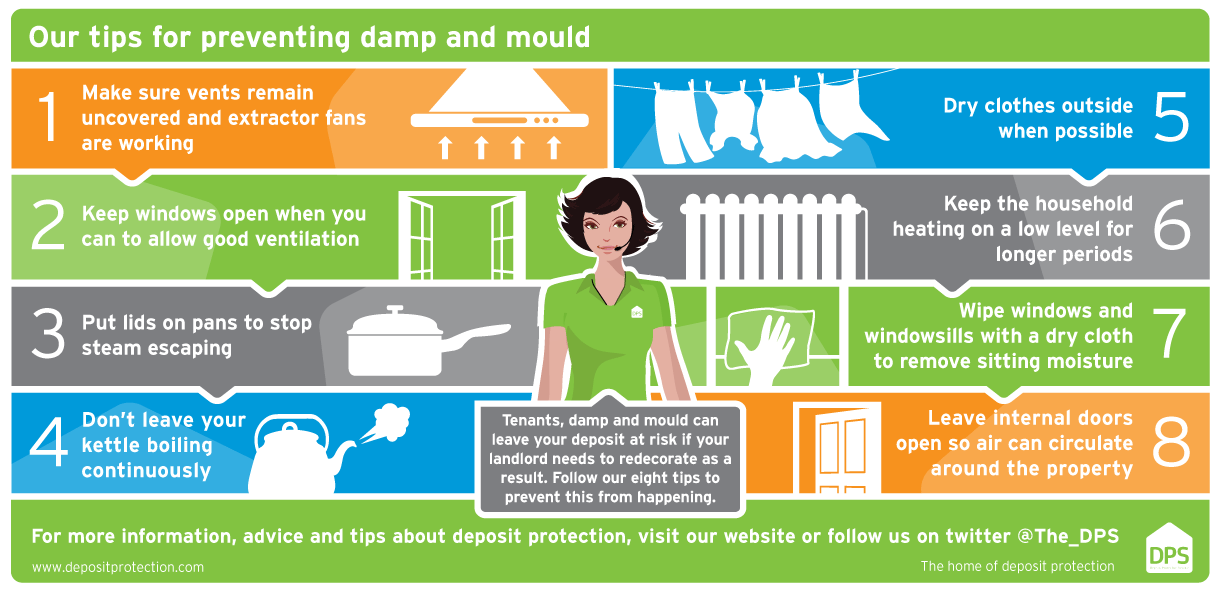TENANTS: Don’t let damp and mould get the better of you this winter!
,
As the nights draw in and the temperatures start to fall, there’s plenty to get excited about; the build-up to Christmas, New Year celebrations and Spring just around the corner. There is, however, a less exciting aspect of winter that could end up costing you if you don’t take precautions: damp.
What is damp?
Damp is the presence of unwanted moisture in the structure of a building. Often manifesting itself in ugly dark patches of mould and grime on walls, floors and ceilings, damp can wreak havoc on the structure of your home, and repairing the damage can cost a great deal of money. In short, it’s no laughing matter.
What causes damp?
As it gets colder outside, temperatures inside houses start to rise as homeowners and tenants put the heating on and then try to keep warm for as long as possible by keeping all doors and windows tightly closed. This is great for keeping us toastie and snug, but it can cause problems.
Warm air trapped inside a house without a means of escape will start to form condensation on surfaces colder than the dew point of the air outside, leading to the moisture you often see building up on windows and walls. This can lead to what’s known as ‘condensation damp’, the most common type in the UK. It’s estimated that around 1 in 5 homes in the UK are affected by this type of damp.

Condensation forming on a window may be an early indicator of damp.
How can you protect your home?
One of the most crucial factors in preventing damp is allowing good circulation of air. In winter, we tend to try to conserve as much heat as possible, keeping heating on, and windows and doors closed. The indoor humidity created when the radiators are on has nowhere to go and starts contributing to damp. In order to allow good circulation…
…try to keep windows open for short, intermittent periods each day.
If your radiators are on, they’ll still be adding to the interior humidity, even if a window is open. To minimise the humidity they create…
…have your radiators on at lower heat for longer periods.
Another common problem that contributes to damp during winter is drying laundry. When the weather is too bad to allow you to dry your clothes outdoors, shirts and socks end up on the radiators, releasing moisture into the house. Try to take of advantage of any clear, windy days to…
…dry your laundry outside as often as possible. Alternatively, dry them in the bathroom with the window open and the door shut.
As you might expect, water vapour is one of the worst contributors to dampness in the home and can be generated by a number of sources. To mitigate this, when taking a bath or shower, you should always do so with the window open, or with the extractor fan on if one is installed. Likewise, in the kitchen, try not to boil the kettle longer than is necessary, and keep lids on boiling pans where possible. In short…
…keep the amount of steam and water vapour in your home to a minimum.
What else can you do?
If you believe damp or mould is present in your home, speak to your landlord immediately. The sooner the problem is identified, the sooner it can be addressed, and if you don’t make your landlord aware in a reasonable timeframe, it could be you who has to foot the bill for redecoration!
What can landlords do?
Be sure to make regular checks of the property, and look for signs of mould during every inspection. This is often where issues such as damp are noted, allowing you to deal with them before they become a problem.
If your tenant alerts you to the fact that there may be damp in your property, have it thoroughly checked by a qualified professional. Dealing with damp can be expensive, so preventative measures should be a lot cheaper than dealing with the problem once it manifests itself.
Before your tenants move in, have the property fitted with vents and extractor fans in the kitchen and bathroom. Try not to use non-porous paints or wall coverings, as these stop the walls from ‘breathing’. If you have laminate flooring anywhere in the property, have the floorboards underneath checked by a qualified professional. Damp can form if laminate is laid too tightly on floorboards.

